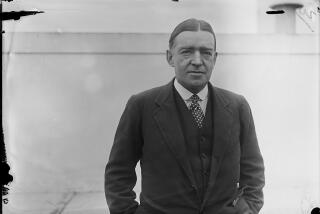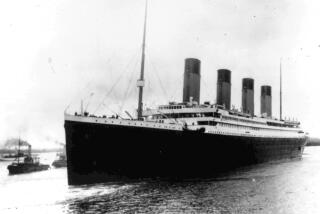Top U.S. Research Vessel Seized Over Trace of Marijuana
- Share via
The Atlantis II, the grand dame of the U.S. research fleet and part of the team that helped explore the Titanic, was seized under the government’s “zero tolerance” drug crackdown after U.S. Customs Service inspectors found a trace of marijuana in a crewman’s shaving kit, officials said Thursday.
The 210-foot vessel, worth about $80 million, had just returned to the United States after an extended research trip off the coast of South America and was undergoing a routine Customs inspection in San Diego on Wednesday when the marijuana residue and two pipes were found, according to Michael Fleming, a Customs spokesman in Los Angeles.
Richard F. Morris, the ship’s second engineer, pleaded guilty Thursday afternoon to a federal misdemeanor charge of possession of a controlled substance.
Ship Will Be Released
The ship was being held Thursday at a Customs inspection station at the 10th Avenue Pier on Diego Bay, but will be released as soon as its owner, the Woods Hole Oceanographic Institution of Woods Hole, Mass., delivers a letter to Customs officials outlining anti-drug precautions to be taken on future expeditions, Fleming said.
The letter will outline security measures and “contain agreements to tighten up their security,” Fleming said. “Customs is convinced the owners of the Atlantis II are innocent parties.”
Because of Atlantis II’s premier position among research vessels, and because it is one of only 25 ships in the National Science Foundation’s academic fleet, researchers sometimes apply years in advance for permission to use the ship. Consequently, a seizure that delayed the vessel beyond its scheduled May 30 departure from San Diego would threaten scientific expeditions that have been years in the planning.
However, Woods Hole spokeswoman Shelley M. Lauzon said she does not anticipate a delay. “The Customs people have been very cooperative,” she said. “They’re working with us.”
The marijuana and two “pot pipes” were found in Morris’ stateroom. The 27-year-old engineer, of Buzzards Bay, Mass., was sentenced to one year of unsupervised probation and fined $100 by U.S. Magistrate Irma Gonzalez. He could not be reached for comment.
Crew members of the ship and the Alvin, a deep-diving submersible carried on its deck, said Thursday that they were gathered in the mess hall while Customs agents and a drug-sniffing dog searched the vessel.
‘Last We Saw of Him’
“Then they came in and called that guy (Morris) out, and that was the last we saw of him,” one Alvin crew member said.
Another crew member said: “We were told that we were all done, thank you very much. They were very cordial. Then we were told by the captain that the ship was seized.”
One crew member said his reaction was “amazement.”
“The point is that the amount of residue that we’re talking about is probably the amount of residue on a hash pipe,” said a scientist who had come to meet the ship to pick up his gear. “It has nothing to do with smuggling. You wouldn’t be smuggling dope at the rate of one joint a day.”
A member of the Alvin crew said: “I think it’s good they picked on a famous research vessel, because they’re showing how ludicrous this law is. They’ve picked on somebody with a little clout who can push back--not like a little fisherman who loses his livelihood because someone on his crew has some drugs in his possession.”
The crew members said Morris was “bullied” into pleading guilty to a misdemeanor and, as a result, will probably lose his license and his job.
“He’s been crucified,” said one crew member.
“We’re not embarrassed about this,” another said. “It’s some muckety-muck high-up Customs guy who should be embarrassed.”
Less Than 0.01 of an Ounce
Under the zero-tolerance program, federal agencies, including Customs and the Coast Guard, have begun seizing boats and automobiles when they are found to contain even minuscule amounts of illegal drugs or drug paraphernalia. The marijuana found in Morris’ shaving kit amounted to 0.25 of a gram, Fleming said--less than 0.01 of an ounce.
Fleming said it is routine for Customs inspectors to examine personal items belonging to crew members arriving from foreign countries. There were 25 crew members aboard the ship, which had departed from Guatemala on May 11, Fleming said. No researchers were aboard, according to Lauzon.
Because there is so much technical equipment on the Atlantis II, Customs is permitting the officers and crew to remain on board, Fleming said. “But the ship cannot depart San Diego,” he said.
The Atlantis II is considered the top ship in the U.S. research fleet because it carries on its deck the Alvin, which has been used in myriad oceanographic discoveries.
Descending to depths of more than 12,000 feet, the Alvin was used in the 1977 discovery of teeming life around hot-water vents in the ocean floor off the Galapagos Islands. The organisms later were found to rely on sulfur instead of carbon for energy, thus verifying for the first time an entirely new basis for life.
Alvin and a remote-controlled “electronic eyeball” called Jason Jr. also caught the public’s fancy in July, 1986, when Robert Ballard of the Woods Hole Institution used the Alvin to locate the wreckage of the Titanic, and Jason Jr. to photograph it.
Atlantis II left Woods Hole on Sept. 20, 1986, and has been working in the Pacific for well over a year, Lauzon said. It is heading north along the Pacific coast to conduct about four months’ of research on the ocean floor off Oregon and Washington, she said.
Its most recent research involved diving on the East Pacific Rise, a zone off Ecuador where two “plates” of ocean crust are spreading apart and exposing hot volcanic rock, Lauzon said. The ship made a port call in Guatemala earlier this month, then departed for San Diego with only the crew aboard, she said.
Lauzon said the ship’s captain had conducted a search for contraband before arriving in San Diego but had not found any.
Although the incident will serve to reinforce to researchers the standing prohibition of drugs on board the ship, Lauzon said, no special notices to them are planned.
“People come from all over the country to use the ship,” she said. “Literally thousands of people use the ship every year. Certainly everybody understands there are federal regulations, but it’s very difficult to control.”
Times staff writer Andrea Estepa contributed to this story.
More to Read
Sign up for Essential California
The most important California stories and recommendations in your inbox every morning.
You may occasionally receive promotional content from the Los Angeles Times.











